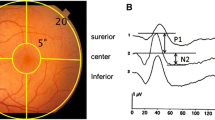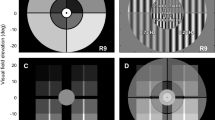Abstract
High and low contrast multifocal ERG (MF-ERG) recordings were obtained from the right eyes of 24 patients with OAG (high-tension OAG: n=16, low-tension OAG: n=8) and compaired to those recorded from 18 healthy volunteers. High contrast MF-ERG recordings were obtained at a mean luminance of 100 cd/m2 with a contrast of 99%, while low contrast MF-ERGs were obtained at a mean luminance of 100 cd/m2 with a contrast of 50%. During MF-ERG recordings the central 50 degrees of the retina were stimulated by 103 hexagons. A MF-ERG recording lasted eight minutes, a M-sequence of 215 was used. The first order response component (KI, mean focal flash response) and the first and second slice of the second order response component (mean focal two flash interaction of flashes one, KII. 1, or two, KII.2, base intervals apart) were analyzed for group differences. Group differences were found mainly in latency measures. These included a delay in the central response average of the first positive peak, P1, in KII.2 (p≤0.05) in OAG high contrast recordings. Low contrast recordings showed a significant delay in the central response average of the first negative peak, N1, in KII.2 as well as in the peripheral response average of N1 in KI and of P1 in KII.2 (p<0.05) in OAG. Amplitudes were only affected significantly in KI of the low contrast recordings. Here the amplitude N1P1 was significantly higher in high tension (n=16) than in low tension (n=8) OAG patients. However, an overlap in all of the response parameters tested allowed only group differences to be characterized. Under these stimulus conditions, neither high contrast recordings nor low contrast recordings seem sensitive enough to reliably recognize early glaucomatous retinal dysfunction.
Similar content being viewed by others
References
Quigley HA. Number of people with glaucoma worldwide. Br J Ophthalmol 1996; 80(5): 389–93.
Krieglstein GK. Erblindung durch Glaukom. [Blindness caused by glaucoma]. Ophthalmologe 1993; 90(6): 554–6.
Caprioli J. Editorial. Recognizing structural damage to the optic nerve head and nerve fiber layer in glaucoma. Am J Ophthalmol 1997; 124(4): 516–20.
Anctil J-L, Anderson DR. Early foveal involvement and generalized depression of the foveal visual field in glaucoma. Arch Ophthalmol 1984; 102: 363–70.
Chauhan BC, LeBlanc RP, Shaw AM, Chan AB, McCormick TA: Repeatable diffuse visual field loss in open-angle glaucoma. Ophthalmology 1997; 104(3): 532–8.
Quigley HA, Addicks EM, Green WR. Optic nerve damage in human glaucoma,III: quantitative correlation of nerve fibre loss and visual field defect in glaucoma, ischaemic neuropathy, papilledema, and toxic neuropathy. Archives of Ophthalmology 1982; 100: 135–46.
Jonas JB, Gruendler AE. Correlation between mean visual field loss and morphometric optic disk variables in the open angle glaucomas. Am J Ophthalmol 1997; 124: 488–97.
Schuman JS, Hee MR, Arya AV et at. Optical coherence tomography: a new tool for glaucoma diagnosis. Curr Opin Ophthalmol 1995; 6(2): 89–95.
Schuman JS, Hee MR, Puliafito CA et at. Quantification of nerve fiber layer thickness in normal and glaucoinatous eyes using optical coherence tomography. Arch Ophthalmol 1995; 113(5): 586–96.
Schuman JS, Pedut-Kloizinan T, Hertzinark E, et al. Reproducibility of nerve fiber layer thickness measurements using optical coherence tomography. Ophthalmology 1996; 103(11): 1889–98.
Bach M, Hiss P, Rdver J. Check-size specific changes of pattern electroretinograin in patients with early open-angle glaucoma. Doc Ophthalmol 1988; 69: 315–22.
Bach M, Pfeiffer N, Birkner-Binder D: Pattern Electroretinogram reflects diffuse retinal damage in early glaucoma. Clin Vision Sci 1992; 7(4): 335–40.
Bach M, Birkner-Binder D, Pfeiffer N. [In incipient glaucoma the pattern electroretinogram displays diffuse, retinal damage]. Ophthalmologe 1993; 90(2): 128–31.
Graham SL, Drance SM, Chauhan BC, et al. Comparison of psychophysical and electrophysiological testing in early glaucoma. Invest Ophthalmol Vis Sci 1996; 37(13): 2651–62.
Pfeiffer N, Bach M. The pattern-electroretinograin in glaucoma and ocular hypertension. A cross-sectional and longitudinal study. Ger J Ophthalmol 1992; 1(1): 35–40.
Pfeiffer N, Tillinon B, Bach M: Predictive value of the pattern electroretinogram in highrisk ocular hypertension. Invest Ophthalmol Vis Sci 1993; 34(5): 1710–5.
Jacobi PC, Walter P, Brunner R, Krieglstein GK. Reproducibility and intraindividual variability of the pattern electroretinogram. Ger. J. Ophthalmol. 1994; 3(4–5): 216–9.
Sutter EE, Vaegan. Lateral interaction component and local luminance nonlinearities in the human pattern reversal ERG. Vision Research 1990; 30(5): 659–71.
Sutter EE, Bearse MA, Jr. Extraction of a ganglion cell component from the corneal response. Vision Science and its Applications, Santa Fe, 1995.
Bearse M, Sutter EE, Smith DN, Stamper R. Ganglion cell components of the multifocal ERG are abnormal in optic nerve atrophy and glaucoma. Invest. Ophthalmol. Vis. Sci. 1995; 36: S445.
Bearse MA, Jr., Sum D, Sutter EE, Stamper R, Lieberman M. Application of the multifocal ERG to glaucoma. Invest. Ophthalmol. Vis. Sci. 1996; 37(3): S511.
Vaegan, Buckland L: The spatial distribution of ERG losses across the posterior pole of glaucomatous eyes in multifocal recordings. Aust NZ J Ophthalmol 1996; 24(2 Suppl): 28–31.
Berninger T, Rudolph G, Hormann C, Zolnikova I, Arden GB. Multifocal-ERG, PERG and colour vision testing in glaucoma patients. International Society for Clinical Electrophysiology of Vision. 36 th Symposium., Hradec Kralove. Czech Republic, 1998, 1998.
Bearse MA, Sutter EE. Contrast dependence of multifocal ERG components. In: America OSo, ed. Vision Science and its Applications, vol 1. Washington DC: Optical Society of America, 1998; 24–27.
Hood DC, Greenstein V, Frishman L et at. Identifying inner retinal contributions to the human multifocal ERG. Vis Res 1999; 39: 2285–91.
Palmowski AM, Sutter EE, Bearse MAJ, Fung W. Mapping of retinal function in diabetic retinopathy using the multifocal electroretinogram. Invest Ophthalmol Vis Sci 1997; 38(12): 2586–96.
Sutter EE, Tran D. The field topography of ERG components in man-I. The photopic luminance response. Vision Research 1992; 32(3): 433–46.
Korth M, Horn F, Storck B, Jonas J. The pattern-evoked electroretinogram (PERG): age-related alterations and changes in glaucoma. 1989; 227: 123–30.
Seeliger MW, Kretschinann UH, Apfelstedt-Sylla, Zrenner B. Implicit time topography of multifocal electroretinograms. Inv Ophthalmol Vis Sci 1998; 39(5): 718–23.
Horiguchi M, Suzuki 5, Kondo M, Tanikawa A, Miyake Y. Effect of glutamate analogues and inhibitory neurotransinitters on the electroretinograms elicited by random sequence stimuli in rabbits. Invest Ophthalinol Vis Sci 1998; 39(11): 2171–6.
Frishman U, Shen FF, Du L et al. The scotopic electroretinogram of macaque after retinal ganglion cell loss from experimental glaucoma. Invest Ophthalmol Vis Sci 1996; 37(1): 125–41.
Bearse MA, Sutter EE, Palinowski AM. New developments toward a clinical test of retinal ganglion cell function. In: America OSo, ed. Vision Science and its Applications, vol 1. Washington DC: Optical Society of America, 1997; 280–83.
Bearse MAJ, Sutter EE, Palmowski AM. Luminance-dependent enhancement of ganglion cell contributions to the human multifocal ERG. Invest Ophthalmol Vis Sci 1997; 38(4): S959.
Sutter EE, Bearse MAJ. The optic nerve head component of the human ERG. Vis Res 1999; 39: 419–36.
Hood D, Frishinan LS, Viswanathan S, Robson J, Ahined J. Evidence for a ganglion cell contribution to the primate electroretinogram (ERG). Effects of TTX on the multifocal ERG in macaque. Vis Neurosci 1999; 96(3): 411–6.
Cahane M, Ashkenazi I, Bartov E. Transient fluorescein leakage simulating subretinal membrane: a diagnostic dilemma. Ann Ophthalmol 1992; 24(7): 271–2.
Quigley HA. Reappraising the risks and benefits of aggressive glaucoma therapy. Invest Ophthalmol Vis 86 1997; 104(12): 1985–6.
Author information
Authors and Affiliations
Rights and permissions
About this article
Cite this article
Palmowski, A.M., Allgayer, R. & Heinemann-Vemaleken, B. The multifocal ERG in open angle glaucoma – A comparison of high and low contrast recordings in high- and low-tension open angle glaucoma. Doc Ophthalmol 101, 35–49 (2000). https://doi.org/10.1023/A:1002710707763
Issue Date:
DOI: https://doi.org/10.1023/A:1002710707763




